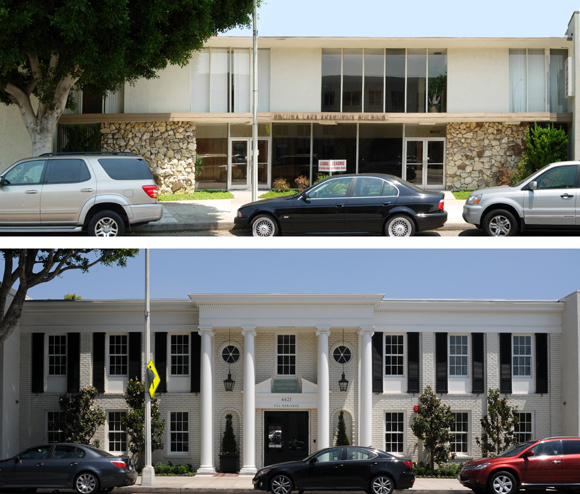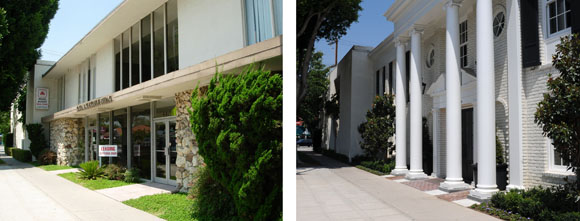
arcCA invited a debate between Tom Marble, AIA, architect for the Toluca Lake Executive Building, and Stephen Slaughter, AIA, a member of the arcCA Editorial Board.
Marble is principal of Marble Architecture in Los Angeles and teaches sporadically at SCI-Arc. He is author of After the city, this (is how we live), recently published by the Los Angeles Forum for Architecture and Urban Design.
Slaughter began his career in Thom Mayne’s studio, Morphosis, and has since worked with respected architects throughout the world, including Gary Bates (Space Lab), Wes Jones (Jones, Partners: Architecture), and George Yu (Design Office/George Yu Architects). PHAT, his multi-disciplinary design collaborative co-founded with Nathaniel Belcher, has exhibited at the Studio Museum in Harlem, Archilab in Orleans, France, and the National Gallery of Victoria, Melbourne, Australia.
The Shock of the Old
Tom Marble, AIA
I am an impurist, a maximalist not a minimalist, a both/and rather than an either/or kind of guy; I like complexity and contradiction, I embrace the ironies of the difficult whole. So when I chose to renovate an office building using a historical style I was not surprised to catch a little flack from my colleagues. But the question, “Is historicism appropriate today?” is not, for me, the interesting question; for me, the interesting question is: “Why does historicism bother us so much?”
In renovating the Toluca Lake Executive Building in Burbank, I chose to summon the ghost of Paul Williams for several reasons. Part of it was related to my ongoing investigation of urban mythology—the idea that a fundamental problem of our era is that the city in our heads has become more important than the actual city. The most radical move in this particular context was to resist the impulse to create a building at the scale of a fast-moving car and to instead offer something that a pedestrian could appreciate. Part of it also plays with cultural critic Norman Klein’s concept of urban erasure: Sure, go ahead and knock down a couple Paul Williams treasures along Wilshire (Perino’s, Cocoanut Grove); but don’t be surprised when some misremembered knock-off appears suddenly across town.
But the bottom line is the effect the building has on passersby. I welcome the pleasantly unsettling quality that the new Toluca Lake Executive Building brings to this stretch of Riverside Drive, lined with classic coffee shops sandwiched between incredibly bland glass-and-stucco office buildings. When you stumble across the building, there’s a cognitive dissonance that asks you to conjure up some sort of logical explanation for its presence when in fact there is none. In my estimation buildings should do this. They should disturb or delight—or both; and not just architects: they should startle even layfolk on their way to grab a quick bite. Architecture, at its best, has the capacity to arouse feelings; at its worst—what we’ve got all over Los Angeles—it is an overarching drabness that induces nothing but indifference.
A hundred years ago, architecture was at a crossroads. Emerging from the ashes of the nineteenth century, two architects came to define the next. Frank Lloyd Wright and Le Corbusier both showed an incredible range of imagination as evidenced in the long evolution of each of their styles. They drew from everything around them for inspiration—art, philosophy, science—and were deeply aware of architectural history, both having practiced in traditional styles early in their careers.
I am convinced architecture is at a crossroads again. After Modernism seemed to fizzle in the ‘60s and ‘70s, we architects cast about looking for new directions. We’ve looked at linguistics (Peter Eisenman), semiotics (Agrest + Gandelsonas), mathematics (Christopher Alexander), movies (Bernard Tschumi), even politics (Paolo Soleri); but mostly we’ve drawn our inspiration from art. There’s Abstract Expressionism (Saarinen, Lautner, Gehry), Pop (Charles Moore, Robert Venturi), Surrealism (Hejduk, Diller+Scofidio), Minimalism (Meier, Ando, Escher GuneWardena), and Conceptualism (Koolhaas, Herzog + De Meuron). I think currently we might be in some sort of Post-Conceptualist phase, a combination of Light & Space, Finish Fetish, and Situationism combined with the unavoidable pull of Sustainability in all its manifestations.
But wherever architecture goes in the coming century, one thing is clear: we need a renewed agility in absorbing the world around us in order to synthesize a new direction. To do this we need to engage in a discourse that is as open and expansive as possible, taking in everything, EVERYTHING. Including history.

Shock. Really?
Stephen Slaughter, AIA
In a collage city with literally hundreds of collage architectural practices and thousands of monuments to these practice’s fits and starts, for an architect both to define himself in opposition to terms that most architects go to pains to avoid, and to propose that designing something “old” in this context is both radical and shocking, is vexing.
I’ll frame this assertion with a few questions. If our mind’s city is more prominent than the city in which we dwell, is it appropriate to cater to nostalgia by faithfully reproducing the work of a deceased architect? If one purports to be a “both/and kinda guy,” why limit the bandwidth of spatial or temporal experience to that of a pedestrian? And, although it’s clear that the intent wasn’t to produce a quasi-Classical façade to reinvigorate the discussion of Meaning in Architecture, the question still remains: Can the insertion of an historical copy into the city avoid the discourse of postmodernism, just because the discussion ceased forty years ago?
Marble seems quite versed in historical references and presents a compelling argument. If I’m allowed to paraphrase: “Why not? Why not keep everything on the table?” So, if the polemic of this project is to question why historicism bothers us so much, the answer is, and has always been, because it is impossible to divorce the meaning embedded in the familiar from the familiar itself, and thereby impossible to present something new and shocking.
Architecture is a medium that allows for a multitude of contexts, influences, and trajectories; and in this era of change—during this, the most difficult time to practice architecture in generations—the onus is on us to not preach multiplicity and practice “past,” but to embrace the new. For it has never been clearer than now that the practices of the past are bankrupt. Or, shall I say, past practices have led us to the brink of economic, social, and cultural collapse. “Business as usual,” along with its ideology and icons, can be no more. The new is the only relevant territory for the future. Historicism must, Mr. Marble, finally rest in peace.
Modernism Is Not a Style
Tom Marble, AIA
I think we’re talking about the same thing, only coming at it differently.
Okay, okay: I know that my renovation of the Toluca Lake Executive Building in Burbank is not a particularly radical gesture. But it’s not a literal copy of any building I am aware of, and, strictly speaking, it’s not even classical; and when you consider that the birth of Hollywood Regency came after the birth of Modernism, I’m not sure calling it historical is even that interesting. I suppose you could call it post-modernist, but, really, is it any more post-modern than anything else that’s going on around us, especially when two recent high-profile buildings in Los Angeles—Disney Hall and the CalTrans building—are simply decorated sheds? And isn’t nostalgia for the future—a future we once owned—just as corrosive as any sort of bourgeois longing for a misremembered past?
That said, would I design a Hollywood Regency building again? As fun as it was to do, I doubt it. Not unless the client and the context called for it. Believe it or not, most of my practice is contemporary in approach and focuses on issues of sustainability in a world of ever-diminishing resources; but I’m still open to the possibility of looking to the past. I mean, why is it that all other arts—painting, sculpture, film, music—can have a more promiscuous relationship with history and absolutely thrive for it, while architecture seems to cling compulsively to a sort of modernist fundamentalism? It’s almost like we’re priests: we’ve taken a vow of celibacy that prevents us from really participating in the world yet compels us to impose our will on it. Let’s face it, we’re anal and we’re arrogant—not a particularly charming combination. Maybe it’s time for a little humility.
Originally published 1st quarter 2009, in arcCA 09.1, “Entitlements.” Re-released in arcCA DIGEST Season 10, “Other Beauty.”





